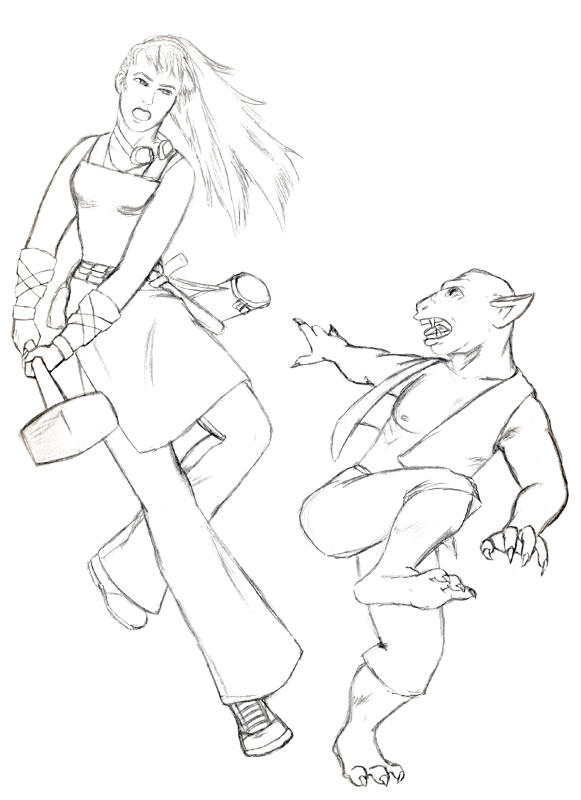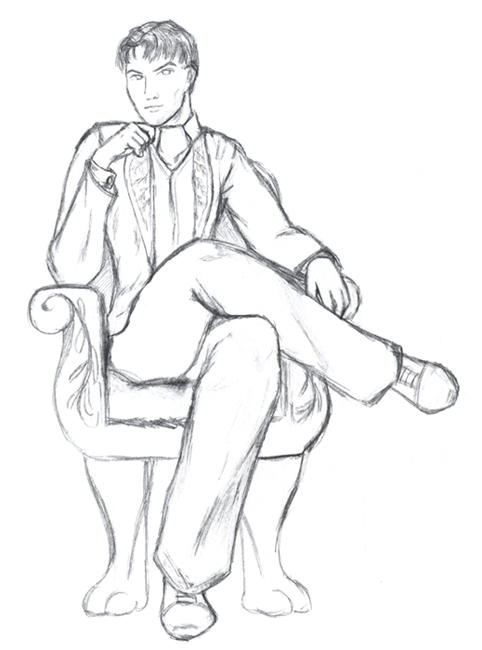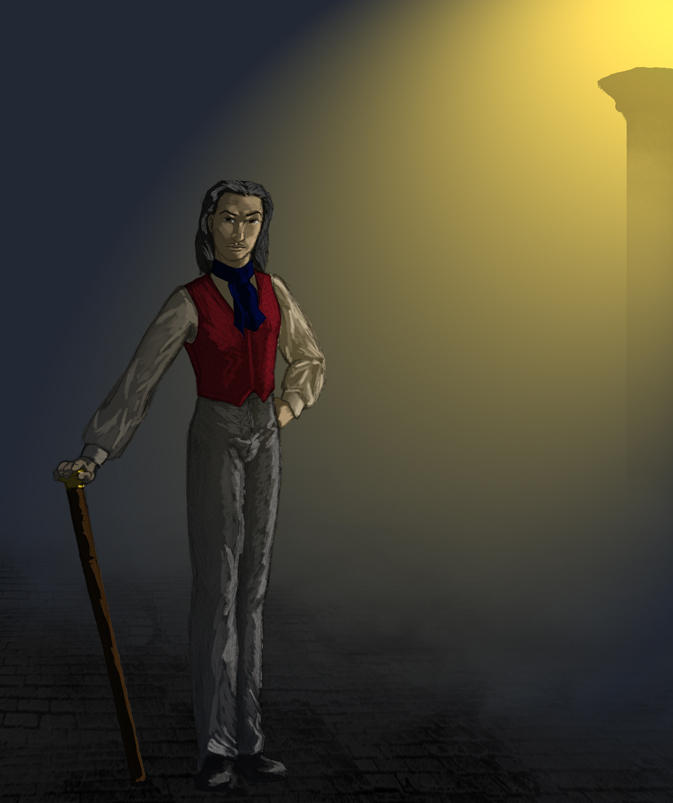This blog is about the literary in video games and electronic media. Reading it brought me to this: a transcript of a talk entitled "A New Vision for Interactive Stories", given at the Game Designer's Conference. It's about how Aristotle, Joe Campbell, and Robert McKee--the elements of the story as we know it--don't necessarily apply to video game stories, the alternative literary structure of video games, and all that jazz. Very interesting.
Then there is this: What is electronic writing? which is about the forms the electronic word can take, and how sometimes those forms aren't even electronic. And this: Second Life, a true virtual reality.
It all makes you think, doesn't it? How new is this, I wonder? It's a whole world of 'what if' developing before us, a future in which science fiction is king. This has long been the purview of games and stories, but today a pilot can make a rocky landing, then analyze all the ways it could have gone wrong and make them 'real' in VR simulations, for the benefit of future pilots. Through huge online 'games' like Second Life, we are developing the body of information we need to elevate sociology and psychology onto the plane of 'true' science that they've been denied for so long. 'What if' is becoming increasingly realistic, so that someday, perhaps 'what if' can seriously take place in, say, a simulation of a major war. If the Bomb hadn't been dropped? If the US had gotten involved sooner? If we'd waited to invade Iraq, like everyone wanted?
Stories, meanwhile, are being told in completely new ways. In fact, can they still be called stories, by the classic definition? Certainly they're new forms of literary expression that have never been seen before.
In short, I wonder whether this will change the world. I wonder whether we're standing on the brink of a revolution in thought process that hasn't happened, perhaps, since the advent of writing, or at least the printing press. Will entirely new ways of interacting with the world come about?
Wednesday, March 29, 2006
Friday, March 17, 2006
Twerpie update; and more art
New art here. It's not much. Just some lineart that I doodled around with. But I sort of like it.
The Twerpie is doing well. She has two kidney stones left after surgical removal, because they were located in troublesome spots in the kidney. As per doctor's orders, we have turned her upside down and thumped her back to dislodge them and encourage them to pass. She's feeling much better--well enough to pick on me again (it was rough going there for a few days, as she felt so lousy that "Try not to throw up on your sister" couldn't even get a smile out of her), and hopes to return to work on Monday. She also plans to kick the urologist in the kneecaps for various aggravating things during this whole ordeal (such as putting off the operation for two weeks while he fussed about with techniques that are proven not to work on cystine stones), and has asked her GP for a different one in the future.
And for my politically-minded friends: UNMASKING UNRWA. The UN may not be so impartial after all. Hamas members working in the UNRWA?
The Twerpie is doing well. She has two kidney stones left after surgical removal, because they were located in troublesome spots in the kidney. As per doctor's orders, we have turned her upside down and thumped her back to dislodge them and encourage them to pass. She's feeling much better--well enough to pick on me again (it was rough going there for a few days, as she felt so lousy that "Try not to throw up on your sister" couldn't even get a smile out of her), and hopes to return to work on Monday. She also plans to kick the urologist in the kneecaps for various aggravating things during this whole ordeal (such as putting off the operation for two weeks while he fussed about with techniques that are proven not to work on cystine stones), and has asked her GP for a different one in the future.
And for my politically-minded friends: UNMASKING UNRWA. The UN may not be so impartial after all. Hamas members working in the UNRWA?
Monday, March 13, 2006
My sister
Since there are a rare few people whom I know but don't get to talk to very often, I guess I ought to update you:
My sister has kidney stones again. She's pretty messed up; been at this for...geez, four weeks now. She's not as sick as the last two times, but she's been in and out of the hospital for short stints due to severe nausea. After fiddling with non-surgical attempts for a while, they finally went in last week and removed the majority of the stones (apparently there were a lot), but they weren't able to get two of them, because her kidney kept shifting due to her breathing.
So they put a stent in, a little doohickey that keeps the kidney from swelling closed due to all the irritation, and said (I kid you not) to turn her upside down and whack her on the back a few times, to dislodge the stones so she can pass them.
Unfortunately, she's been too nauseated for us to do so, ever since the surgery. She's feeling a bit better today, and they plan to remove the stent today, which is good. That might lessen the nausea. Last time she had one of those in, it made her horribly sick.
In other news: Switch. Off.: a funny website about how to get your life back on track. Dave requested it.
My sister has kidney stones again. She's pretty messed up; been at this for...geez, four weeks now. She's not as sick as the last two times, but she's been in and out of the hospital for short stints due to severe nausea. After fiddling with non-surgical attempts for a while, they finally went in last week and removed the majority of the stones (apparently there were a lot), but they weren't able to get two of them, because her kidney kept shifting due to her breathing.
So they put a stent in, a little doohickey that keeps the kidney from swelling closed due to all the irritation, and said (I kid you not) to turn her upside down and whack her on the back a few times, to dislodge the stones so she can pass them.
Unfortunately, she's been too nauseated for us to do so, ever since the surgery. She's feeling a bit better today, and they plan to remove the stent today, which is good. That might lessen the nausea. Last time she had one of those in, it made her horribly sick.
In other news: Switch. Off.: a funny website about how to get your life back on track. Dave requested it.
Saturday, March 11, 2006
Wednesday, March 08, 2006
Cold Fusion. No, seriously.
Well. Damn.
Now, this isn't self-sustaining cold fusion, which is the sort that would produce the endless energy. However,the sheer proof that it can be done is mind-boggling, and improvements will follow.
NY team confirms UCLA tabletop fusion.
Researchers at Rensselaer Polytechnic Institute have developed a tabletop accelerator that produces nuclear fusion at room temperature, providing confirmation of an earlier experiment conducted at the University of California, Los Angeles (UCLA), while offering substantial improvements over the original design.
The device, which uses two opposing crystals to generate a powerful electric field, could potentially lead to a portable, battery-operated neutron generator for a variety of applications, from non-destructive testing to detecting explosives and scanning luggage at airports. The new results are described in the Feb. 10 issue of Physical Review Letters.
"Our study shows that 'crystal fusion' is a mature technology with considerable commercial potential," says Yaron Danon, associate professor of mechanical, aerospace, and nuclear engineering at Rensselaer. "This new device is simpler and less expensive than the previous version, and it has the potential to produce even more neutrons."
The device is essentially a tabletop particle accelerator. At its heart are two opposing "pyroelectric" crystals that create a strong electric field when heated or cooled. The device is filled with deuterium gas -- a more massive cousin of hydrogen with an extra neutron in its nucleus. The electric field rips electrons from the gas, creating deuterium ions and accelerating them into a deuterium target on one of the crystals. When the particles smash into the target, neutrons are emitted, which is the telltale sign that nuclear fusion has occurred, according to Danon.
A research team led by Seth Putterman, professor of physics at UCLA, reported on a similar apparatus in 2005, but two important features distinguish the new device: "Our device uses two crystals instead of one, which doubles the acceleration potential," says Jeffrey Geuther, a graduate student in nuclear engineering at Rensselaer and lead author of the paper. "And our setup does not require cooling the crystals to cryogenic temperatures -- an important step that reduces both the complexity and the cost of the equipment."
The new study also verified the fundamental physics behind the original experiment. This suggests that pyroelectric crystals are in fact a viable means of producing nuclear fusion, and that commercial applications may be closer than originally thought, according to Danon.
"Nuclear fusion has been explored as a potential source of power, but we are not looking at this as an energy source right now," Danon says. Rather, the most immediate application may come in the form of a battery-operated, portable neutron generator. Such a device could be used to detect explosives or to scan luggage at airports, and it could also be an important tool for a wide range of laboratory experiments.
The concept could also lead to a portable x-ray generator, according to Danon. "There is already a commercial portable pyroelectric x-ray product available, but it does not produce enough energy to provide the 50,000 electron volts needed for medical imaging," he says. "Our device is capable of producing about 200,000 electron volts, which could meet these requirements and could also be enough to penetrate several millimeters of steel."
In the more distant future, Danon envisions a number of other medical applications of pyroelectric crystals, including a wearable device that could provide safe, continuous cancer treatment.
From Rensselaer Polytechnic Institute
Now, this isn't self-sustaining cold fusion, which is the sort that would produce the endless energy. However,the sheer proof that it can be done is mind-boggling, and improvements will follow.
NY team confirms UCLA tabletop fusion.
Researchers at Rensselaer Polytechnic Institute have developed a tabletop accelerator that produces nuclear fusion at room temperature, providing confirmation of an earlier experiment conducted at the University of California, Los Angeles (UCLA), while offering substantial improvements over the original design.
The device, which uses two opposing crystals to generate a powerful electric field, could potentially lead to a portable, battery-operated neutron generator for a variety of applications, from non-destructive testing to detecting explosives and scanning luggage at airports. The new results are described in the Feb. 10 issue of Physical Review Letters.
"Our study shows that 'crystal fusion' is a mature technology with considerable commercial potential," says Yaron Danon, associate professor of mechanical, aerospace, and nuclear engineering at Rensselaer. "This new device is simpler and less expensive than the previous version, and it has the potential to produce even more neutrons."
The device is essentially a tabletop particle accelerator. At its heart are two opposing "pyroelectric" crystals that create a strong electric field when heated or cooled. The device is filled with deuterium gas -- a more massive cousin of hydrogen with an extra neutron in its nucleus. The electric field rips electrons from the gas, creating deuterium ions and accelerating them into a deuterium target on one of the crystals. When the particles smash into the target, neutrons are emitted, which is the telltale sign that nuclear fusion has occurred, according to Danon.
A research team led by Seth Putterman, professor of physics at UCLA, reported on a similar apparatus in 2005, but two important features distinguish the new device: "Our device uses two crystals instead of one, which doubles the acceleration potential," says Jeffrey Geuther, a graduate student in nuclear engineering at Rensselaer and lead author of the paper. "And our setup does not require cooling the crystals to cryogenic temperatures -- an important step that reduces both the complexity and the cost of the equipment."
The new study also verified the fundamental physics behind the original experiment. This suggests that pyroelectric crystals are in fact a viable means of producing nuclear fusion, and that commercial applications may be closer than originally thought, according to Danon.
"Nuclear fusion has been explored as a potential source of power, but we are not looking at this as an energy source right now," Danon says. Rather, the most immediate application may come in the form of a battery-operated, portable neutron generator. Such a device could be used to detect explosives or to scan luggage at airports, and it could also be an important tool for a wide range of laboratory experiments.
The concept could also lead to a portable x-ray generator, according to Danon. "There is already a commercial portable pyroelectric x-ray product available, but it does not produce enough energy to provide the 50,000 electron volts needed for medical imaging," he says. "Our device is capable of producing about 200,000 electron volts, which could meet these requirements and could also be enough to penetrate several millimeters of steel."
In the more distant future, Danon envisions a number of other medical applications of pyroelectric crystals, including a wearable device that could provide safe, continuous cancer treatment.
From Rensselaer Polytechnic Institute
Monday, March 06, 2006
Interesting political articles
Hmm. We've got: Bush Lied, People Died?--an interview with the Iraqi ex-general who wrote that book about how there were WMDs in there after all.
We also have: A Muslim Leader in Brooklyn. (Be aware that's a NYTimes link, and thus will turn into a pumpkin at midnight...or vanish from general access on Friday, or something like that.)
Ah, and this isn't so much political, but it is an interest point of view: Luthernan Theology Translaters: now wouldn't that be nice!
We also have: A Muslim Leader in Brooklyn. (Be aware that's a NYTimes link, and thus will turn into a pumpkin at midnight...or vanish from general access on Friday, or something like that.)
Ah, and this isn't so much political, but it is an interest point of view: Luthernan Theology Translaters: now wouldn't that be nice!
Subscribe to:
Posts (Atom)


